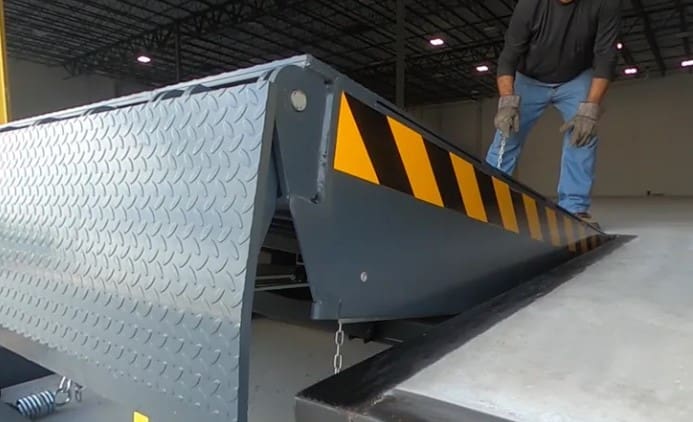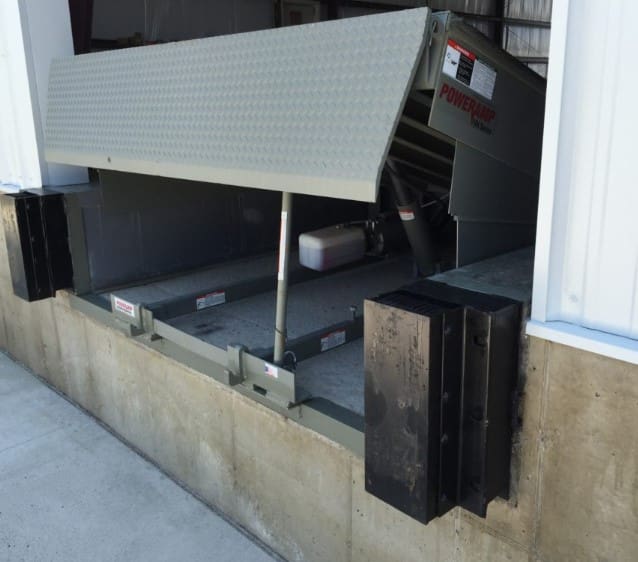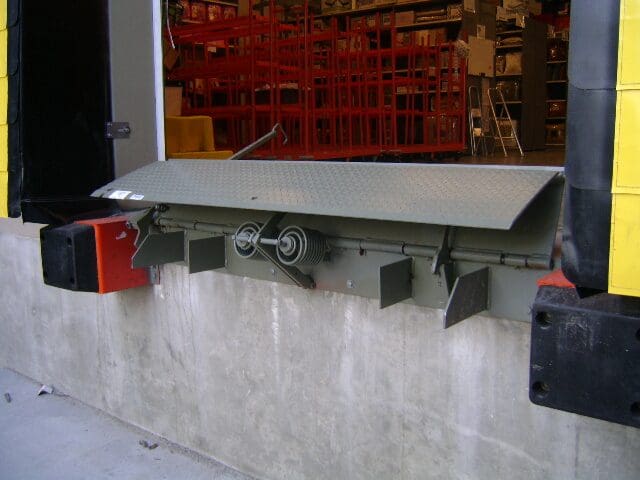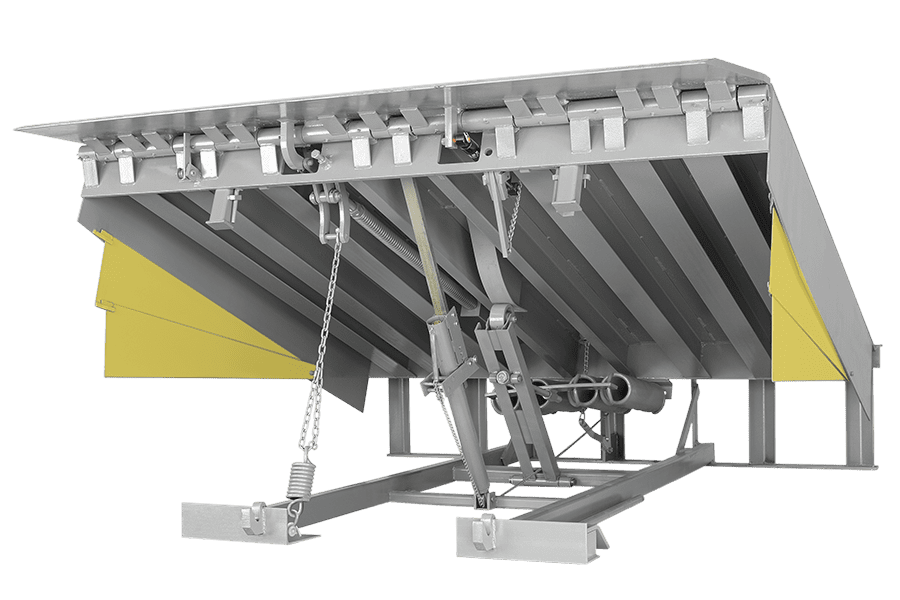Dock Equipment
Dock Levelers
A dock leveler is a piece of equipment used in loading docks to bridge the gap between a warehouse or facility floor and the bed of a truck or trailer. It ensures smooth and efficient loading and unloading of goods by providing a safe and level transition between the dock and the vehicle. Here are the key features, components, and functions of a dock leveler:
Key Features
-
Adjustable Height: Dock levelers are adjustable to match the height of various truck beds, trailers, or loading platforms, ensuring a seamless connection.
-
Loading Capacity: Designed to support heavy loads, typically ranging from several thousand to tens of thousands of pounds, depending on the model and configuration.
-
Durability: Constructed from robust materials such as steel or aluminum to withstand heavy use and withstand the weight of loaded trucks and equipment.
-
Safety Features: Equipped with safety features such as lip locks, toe guards, and safety maintenance struts to prevent accidents and injuries during operation.
Components
-
Lip: The lip is a hinged or telescoping ramp that extends from the dock leveler onto the bed of the truck or trailer, providing a smooth transition for forklifts or pallet jacks.
-
Deck Plate: The deck plate is the main surface of the dock leveler, typically made of steel or aluminum, where workers and equipment stand while loading or unloading goods.
-
Hydraulic or Mechanical System: Dock levelers are operated using hydraulic or mechanical systems to raise, lower, and position the deck plate and lip.
-
Support Structure: The support structure consists of beams, gussets, and other components that provide stability and structural integrity to the dock leveler.
Functions
-
Bridge the Gap: Dock levelers bridge the height difference between the dock floor and the truck bed, allowing forklifts, pallet jacks, and other equipment to move goods between them.
-
Facilitate Loading and Unloading: By providing a smooth and level transition, dock levelers facilitate the efficient loading and unloading of goods, reducing handling time and minimizing the risk of damage to products and equipment.
-
Enhance Safety: Dock levelers are equipped with safety features to prevent accidents and injuries, such as lip locks to secure the lip in place and toe guards to protect against tripping hazards.
-
Improve Productivity: By streamlining the loading and unloading process, dock levelers help improve productivity and workflow efficiency in warehouses and distribution centers.
Types of Dock Levelers
-
Hydraulic Dock Levelers: Operated using hydraulic systems for smooth and precise positioning, offering ease of use and reliability.
-
Mechanical Dock Levelers: Operated manually or using mechanical systems such as springs or counterweights, providing a cost-effective alternative to hydraulic levelers.
-
Air-Powered Dock Levelers: Utilize airbags or pneumatic systems to raise and lower the deck plate, offering flexibility and energy efficiency.
Applications:
Dock levelers are used in various industries and facilities, including:
-
Warehouses
-
Distribution centers
-
Manufacturing plants
-
Retail stores
-
Freight terminals
-
Logistics hubs
Benefits
-
Efficiency: Streamlines loading and unloading operations, reducing downtime and improving workflow efficiency.
-
Safety: Enhances worker safety by providing a stable and level transition between the dock and the truck bed.
-
Versatility: Compatible with various types of trucks, trailers, and loading platforms, accommodating different loading scenarios.
-
Cost Savings: Helps minimize product damage, equipment wear, and labor costs associated with manual loading and unloading processes.
In summary, dock levelers are essential equipment in loading docks, providing a safe, efficient, and reliable means of transferring goods between trucks and warehouse facilities. With their sturdy construction, adjustable features, and safety enhancements, dock levelers play a critical role in optimizing material handling operations and maximizing productivity in modern supply chain environments.
Warehouse Rolling Doors
A warehouse rolling door, also known as a roll-up door or rolling shutter door, is a type of door commonly used in industrial and commercial settings, including warehouses, storage facilities, and loading docks. These doors are designed for frequent use, providing security, durability, and ease of access. Here's a detailed explanation of what warehouse rolling doors are and their key features:

Design and Mechanism
-
Slats or Panels: Rolling doors are made up of horizontal slats or panels, typically constructed from materials like steel, aluminum, or fiberglass. These slats are hinged together, allowing the door to roll up into a coil when opened.
-
Rolling Mechanism: The door operates on a rolling mechanism, where it is coiled around a drum or barrel mounted above the door opening. This design allows the door to open vertically and take up minimal space when in the open position.
-
Guides and Tracks: The door moves along vertical guides or tracks installed on either side of the door frame, ensuring smooth and controlled operation.
Types of Rolling Doors
-
Manual Rolling Doors: Operated by hand, often using a pull chain or crank. These are suitable for smaller doors or locations with less frequent usage.
-
Motorized Rolling Doors: Equipped with an electric motor for automatic operation. These doors can be operated via remote control, wall switch, or integrated with automated systems. They are ideal for larger openings and high-traffic areas.
Advantages
-
Space Efficiency: Rolling doors open vertically and coil into a compact roll above the door opening, saving valuable floor and overhead space. This is especially beneficial in areas with limited space.
-
Durability and Security: Constructed from robust materials, rolling doors provide excellent security against unauthorized entry and protection from external elements. They are designed to withstand heavy usage and harsh environments.
-
Ease of Operation: Both manual and motorized rolling doors are designed for smooth and easy operation, facilitating quick and efficient access to the warehouse or storage area.
-
Customization: Rolling doors can be customized to fit specific size requirements and can be equipped with various features such as insulation for temperature control, weather seals, and vision panels for visibility.
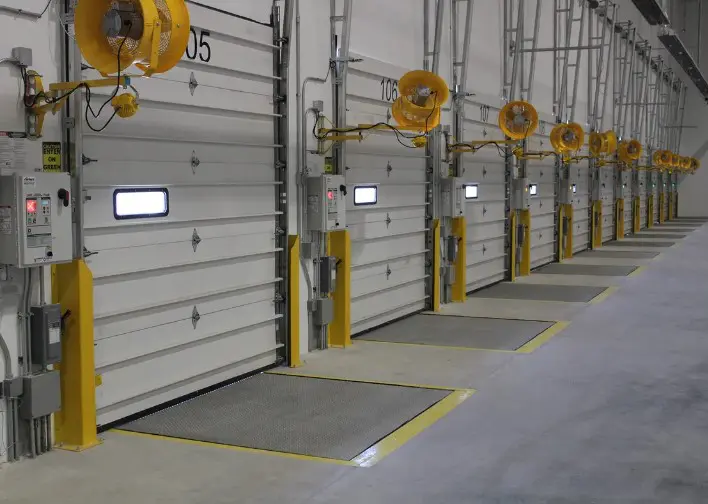
Applications
-
Loading Docks: Commonly used in loading dock areas for efficient loading and unloading of goods.
-
Storage Facilities: Used in storage units and warehouses to secure stored items and provide easy access.
-
Industrial Buildings: Installed in manufacturing plants, workshops, and other industrial settings for secure and convenient access to large openings.
-
Retail and Commercial Spaces: Utilized in storefronts and commercial facilities for security and ease of access.
Maintenance and Safety
-
Regular Maintenance: Rolling doors require regular maintenance to ensure smooth operation and longevity. This includes lubricating moving parts, checking for wear and tear, and ensuring the motor and control systems are functioning correctly.
-
Safety Features: Modern rolling doors often come with safety features such as automatic reversal mechanisms to prevent injury or damage if an obstruction is detected and emergency release systems for manual operation during power failures.
In summary, a warehouse rolling door is a practical and efficient solution for securing and accessing large openings in industrial and commercial settings. Its space-saving design, durability, and ease of operation make it an ideal choice for warehouses and similar environments.
Dock Shelters
A dock shelter is a structure installed at a loading dock to create a seal between the dock and the trailer or truck during loading and unloading operations. It helps to protect goods, equipment, and personnel from outdoor elements such as weather, dust, insects, and debris. Dock shelters are typically made of flexible materials such as fabric or foam and are designed to accommodate various types and sizes of trucks or trailers. Here are the key features, components, and functions of a dock shelter:
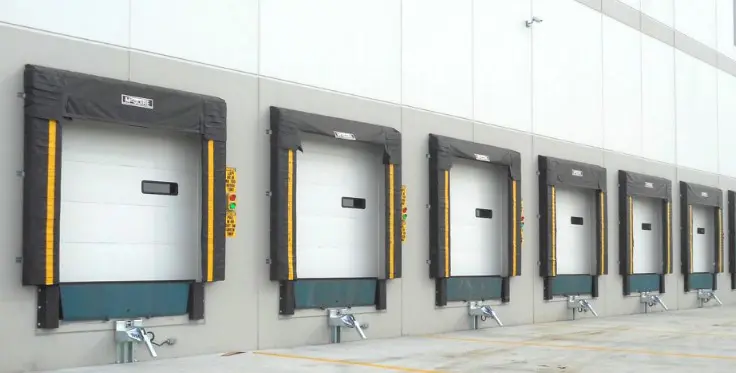
Key Features
-
Flexible Construction: Dock shelters are made of flexible materials such as fabric or foam, allowing them to conform to the shape of the truck or trailer during loading and unloading.
-
Sealing Mechanism: Dock shelters create a tight seal around the perimeter of the trailer or truck, preventing the ingress of outdoor elements into the loading dock area.
-
Retractable Design: Some dock shelters have retractable or collapsible features that allow them to accommodate trucks or trailers of different sizes and configurations.
-
Head Curtain: Many dock shelters feature a head curtain at the top of the structure to provide additional sealing at the top of the trailer or truck.
Components
-
Fabric Panels: The main body of the dock shelter is typically made of fabric panels that provide flexibility and durability.
-
Foam Pads: Foam pads or cushions are often used on the sides and top of the dock shelter to create a cushioned seal against the trailer or truck.
-
Support Structure: A rigid support structure, usually made of steel or aluminum, provides stability and strength to the dock shelter.
-
Retractable Mechanism: In dock shelters with retractable features, a system of pulleys, cables, or springs allows the shelter to expand and retract as needed.
Functions
-
Weather Protection: Dock shelters provide protection from weather elements such as rain, snow, wind, and sunlight, helping to maintain a controlled environment within the loading dock area.
-
Dust and Debris Control: By creating a seal between the dock and the trailer or truck, dock shelters help prevent the ingress of dust, dirt, and debris into the warehouse or facility.
-
Insect Prevention: Dock shelters help to keep insects and pests out of the loading dock area, reducing the risk of contamination and damage to goods.
-
Energy Efficiency: By minimizing air leakage and maintaining a consistent temperature inside the loading dock area, dock shelters contribute to energy efficiency and cost savings.

Types of Dock Shelters
-
Rigid Dock Shelters: Made of rigid frames and fabric panels, providing a durable and long-lasting solution for sealing loading docks.
-
Inflatable Dock Shelters: Utilize inflatable airbags or bladders to create a seal around the trailer or truck, offering flexibility and adaptability to different truck sizes.
-
Retractable Dock Shelters: Feature retractable or collapsible designs that can expand or retract to accommodate trucks or trailers of various sizes and configurations.
Benefits
-
Protection: Protects goods, equipment, and personnel from weather elements, dust, debris, and insects during loading and unloading operations.
-
Energy Savings: Contributes to energy efficiency by minimizing air leakage and maintaining a consistent temperature inside the loading dock area.
-
Productivity: Helps maintain a controlled environment for efficient loading and unloading operations, reducing downtime and delays.
-
Safety: Improves safety for workers by providing a secure and comfortable working environment within the loading dock area.
-
Cost Savings: Helps reduce maintenance costs and extend the lifespan of equipment by minimizing exposure to outdoor elements.
In summary, a dock shelter is an essential component of a loading dock area, providing protection from weather elements, dust, debris, and insects while also contributing to energy efficiency, productivity, and safety during loading and unloading operations.

